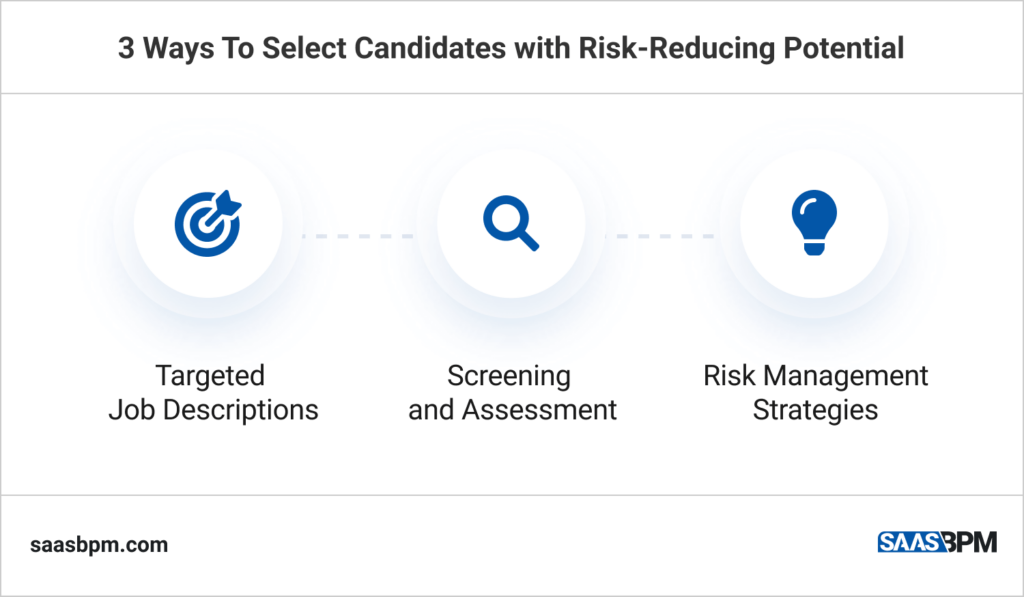In today’s rapidly changing business landscape, organizations often face the challenge of reducing financial risk as, ignoring it can significantly impact their stability and success. Managing these challenges, from economic downturns to industry disruptions, has become paramount for long-term sustainability.
One crucial avenue for reducing financial risk lies in the strategic planning and recruitment efforts of the Human Resources (HR) department.
HR planning has always been an important topic for businesses, with companies losing about $550 billion annually due to workers feeling disengaged or dissatisfied. This statistic shows a critical link between HR practices and the overall financial well-being of a company.
Organizations can proactively identify, assess, and minimize potential financial pitfalls by strategically aligning HR functions with risk management objectives.
This article will explore reducing financial risk through strategic HR planning and recruitment. We will explore the intricate relationship between HR practices and financial risk management, highlighting key considerations and actionable strategies.
The Link Between HR Planning and Financial Risk Reduction

Financial risks lurk around every corner in the business world, ready to ambush even the most prepared organizations. These risks can manifest in various forms, such as economic downturns, regulatory changes, or unexpected market shifts.
However, organizations equipped with the power of strategic HR planning and recruitment have an extraordinary advantage in their battle against these financial adversaries.
Imagine HR planning as a compass that guides an organization’s journey through the treacherous waters of financial risk. It involves carefully mapping workforce needs, identifying talent gaps, and devising strategies to attract, develop, and retain skilled professionals.
But what does HR planning have to do with financial risk reduction, you might wonder?
Well, the link is more profound than meets the eye. Strategic HR planning is a sturdy bridge connecting human capital management with financial stability. It enables organizations to proactively anticipate and address risks. How? By aligning their talent acquisition and development efforts with the overarching financial objectives.
Without an adequate workforce to handle essential functions, the organization’s productivity may plummet, customer satisfaction could dwindle, and revenues may suffer. The financial risk increases exponentially when there is a lack of skilled personnel.
On the other hand, organizations with well-executed HR planning strategies have a formidable shield against financial risks. By conducting comprehensive workforce analyses, they identify vital positions crucial for risk management and implement succession plans to ensure continuity.
By investing in the advancement and growth of their personnel, organizations amplify their capacity to handle financial challenges effectively. They equip employees with the necessary proficiencies and knowledge. This way, the team members can make well-informed decisions, diminish errors, and promptly react to financial threats.
Strategic Recruitment for Financial Risk Reduction
Strategic recruitment plays a pivotal role in minimizing financial risks. Companies can proactively address potential financial vulnerabilities by carefully selecting and onboarding individuals with the right skills, competencies, and mindset.
In this section, we will explore the significance of strategic recruitment and delve into critical considerations for effectively reducing financial risks.
Importance of Recruitment in Financial Risk Reduction
Consider a scenario where a company employs individuals without evaluating their aptitude for risk management positions. This might lead to staff lacking the expertise to recognize and alleviate financial risks, leaving the organization vulnerable to potential losses.
Strategic recruitment aims to prevent such situations by identifying candidates who possess the indispensable attributes required for minimizing financial risks.
Key Considerations for Strategic Recruitment

• Identifying Critical Positions for Risk Mitigation: The initial phase in strategic recruitment involves recognizing the vital roles that directly influence financial risk management. These responsibilities encompass finance, compliance, auditing, and risk management roles.
It is essential that you prioritize the recruitment procedure for these crucial positions. This will guarantee that you acquire the required expertise to confront potential financial challenges head-on.
• Assessing Skills and Competencies for Risk Management: Beyond traditional qualifications and experience, strategic recruitment underscores assessing applicants’ abilities and proficiencies concerning financial risk management.
These include analytical thinking, problem solving, attention to detail, and a robust comprehension of financial markets and regulations. It is imperative to assess these characteristics while undertaking the recruitment procedure scrupulously.
Doing this can increase the likelihood of finding well-equipped individuals to handle financial risks effectively.
• Evaluating Cultural Fit and Ethical Behavior: Besides technical skills, cultural fit and ethical behavior are crucial considerations for strategic recruitment. Employees who align with the organization’s core values and ethical standards are likely to make sound decisions and act in the company’s best interests.
Ensuring a solid cultural fit helps foster a risk-aware and responsible work environment, reducing the chances of financial misconduct or negligence.
Techniques for Attracting and Selecting Candidates with Risk-Reducing Potential
Strategic recruitment employs various methods to attract and select candidates with a propensity for financial risk reduction:

• Targeted Job Descriptions and Advertisements: Crafting job descriptions explicitly outlining risk management’s importance can attract candidates with relevant experience and skills. Job advertisements can highlight the organization’s commitment to financial risk reduction and the opportunities for professional growth in this area.
• Screening and Assessment Tools: Screening and assessment tools like structured interviews, behavioral reviews, and case studies can provide valuable insights into a candidate’s risk management capabilities. These tools can help gauge a candidate’s ability to effectively identify, analyze, and respond to financial risks.
• Collaboration with Risk Management Professionals: Collaborating with risk management professionals within the organization or external experts can provide valuable input during the recruitment process. Their expertise can help identify specific traits or experiences that indicate a candidate’s potential for financial risk reduction.
There’s no doubt that strategic recruitment is a powerful mechanism for reducing financial risks within an organization. Remember, it all starts with attracting and selecting the right individuals capable and driven to safeguard the company’s financial well-being.
Employee Development and Training for Financial Risk Management
Staying ahead of financial risks is a constant challenge in the constantly changing realm of finance and business. Hence, companies should furnish their staff with the knowledge, skills, and instruments to maneuver the intricate world of risk management. This is where employee development and training enter the frame.
Suppose you work with a group of individuals equipped with the proficiency to recognize possible risks, assess their consequences, and even execute measures to alleviate them. That could have a substantial impact on your business!
This explains why there’s a need to invest in employee development and training programs tailored to financial risk management, as it will assist you in building a workforce that shields against potential financial storms.
So, how do you go about employee development for financial risk management? First, it begins with a clear and comprehensive understanding of the organization’s risks.
You must identify areas where your employees need to enhance their skills and knowledge to contribute their quota to risk reduction efforts effectively. It can range from financial analysis techniques and forecasting methodologies to regulatory compliance and industry-specific risk factors.
After the training needs have been outlined, the next step is designing and implementing the targeted training programs. Beyond theoretical knowledge, these programs should incorporate practical exercises and simulations that mirror real-world financial risk scenarios.
Regarding employee development in financial risk management, there’s also a place for continuous learning. Keeping pace with emerging technological trends and regulatory changes that impact the financial landscape is essential.
Evaluation also plays a crucial role in employee development for financial risk management. Regular assessments, both during and after training programs, help gauge the effectiveness of the training initiatives.
These assessments can be quizzes, case studies, or practical assignments that allow employees to apply their newly acquired skills.
Compliance and Legal Considerations
When mitigating financial uncertainty through strategic HR planning and recruitment, conformity with laws and regulations is an essential factor that organizations cannot ignore.
Lawful Compliance
Neglecting to abide by legal requirements can subject companies to significant financial penalties, damaging their reputation and potentially even legal proceedings. Hence, comprehending and tackling compliance and legal considerations are paramount for efficient risk mitigation.
Imagine this scenario: a company invests significant time and resources in recruiting a top-notch executive to lead its finance team. There’s excitement in the air about the potential impact this individual can have on their financial stability.
However, unknowingly to them, the candidate has a history of engaging in unethical financial practices. This oversight taints the company’s financial integrity and exposes them to legal liabilities.
To avoid such detrimental situations, businesses must establish robust HR policies and procedures that align with applicable laws and regulations.
As a general guideline, these policies should encompass equal employment opportunities, anti-discrimination measures, wage and hour compliance, and data privacy.
Industry-Specific Regulations
Furthermore, besides lawful compliance, organizations must contemplate industry-specific regulations that may affect their financial risk management endeavors. For instance, financial establishments must navigate strict principles enforced by governing entities like the Securities and Exchange Commission (SEC) or the Financial Industry Regulatory Authority (FINRA).
These regulations often prescribe precise recruitment practices, qualifications, and reporting prerequisites, ensuring that companies in the financial sector uphold the utmost level of honesty and responsibility.
Moreover, it is crucial to maintain adherence to laws about employee perks, such as healthcare insurance, worker’s compensation, and retirement schemes. Neglecting to comply with these regulations can lead to significant financial liabilities, penalties, and potential employee lawsuits.
Companies must stay up-to-date with the ever-evolving legal landscape, ensuring their HR practices remain compliant and aligned with current regulations.
To address compliance and legal considerations effectively, companies can decide to establish a dedicated HR compliance team or engage legal experts to provide guidance.
The responsibility of this team is to regularly review HR policies and practices, conduct internal audits, and stay informed about changes in legislation. They would work closely with the HR department to ensure that recruitment processes align with legal requirements and that employees receive proper training on compliance-related matters.
Monitoring and Evaluation
In the quest to reduce financial risk through strategic HR planning and recruitment, the journey doesn’t end with implementation. Establishing a robust monitoring and evaluation system is crucial to ensure the effectiveness of your risk mitigation strategies. After all, what gets measured gets managed.
Imagine sailing a ship through treacherous waters without gauging your progress or detecting potential dangers. Monitoring and evaluation in the context of financial risk reduction act as your navigational instruments. They guide you toward safe harbors and steering you away from impending storms.
Establishing Metrics for Measuring Financial Risk Reduction

To effectively monitor and evaluate the impact of your HR strategies on financial risk reduction, it is essential to develop appropriate metrics. These metrics should align with your organization’s specific risk management objectives.
For instance, you might measure metrics such as cost savings achieved through efficient recruitment, turnover rates in critical risk-exposed positions, or the success of training programs in enhancing employee risk awareness. By quantifying the outcomes, you gain valuable insights into the effectiveness of your HR initiatives and their contribution to financial risk reduction.
Continuous Monitoring of HR Strategies and Outcomes
Monitoring should not be a one-time activity but an ongoing process integrated into your organization’s DNA. Regularly track the performance of your HR strategies and their impact on financial risk reduction.
Are your recruitment practices attracting candidates with risk-reducing potential? Is your training program effectively equipping employees with the necessary skills to manage financial risks? By continuously monitoring these aspects, you can identify any deviations or areas of improvement, allowing for timely adjustments to keep your risk mitigation efforts on course.
Periodic Evaluation and Adjustment of HR Practices
In addition to continuous monitoring, regular evaluation is crucial to assess the long-term effectiveness of your HR practices. Conduct comprehensive reviews of your HR planning and recruitment strategies to gauge their impact on financial risk reduction.
Analyze the trends, patterns, and outcomes to identify strengths, weaknesses, and opportunities for improvement. This evaluation process lets you fine-tune your strategies, discard ineffective practices, and reinforce successful ones. When you embrace a culture of continuous improvement, you enhance the alignment between your HR initiatives and the organization’s financial risk reduction goals.
Monitoring and evaluation form a dynamic feedback loop that enables you to gauge the effectiveness of your HR efforts in reducing financial risk. It empowers you with the insights to make data-driven decisions, ensuring your HR strategies remain responsive and adaptable to the ever-evolving risk landscape.
Think of monitoring and evaluation as your organization’s “risk radar,” scanning the horizon for potential threats and guiding you toward proactive measures. It enables you to assess your HR initiatives’ return on investment (ROI), whether it’s a high-yield investment or not. This demonstrates the value they bring in safeguarding your financial stability.
By diligently monitoring and evaluating your HR practices, you comprehensively understand their impact and demonstrate accountability to stakeholders. This fosters a culture of transparency and continuous improvement within your organization, laying a solid foundation for effective financial risk management.
Conclusion
It is crystal clear that strategic HR planning and recruitment play a vital role in reducing financial risk within organizations. By recognizing the importance of financial risk reduction and implementing effective HR strategies, businesses can safeguard their financial stability and long-term success.
If left unaddressed, financial risks can have grave consequences for an organization, such as loss of revenue, reputation damage, and even potential insolvency. However, through the lens of strategic HR planning, you can proactively identify and mitigate these risks, ensuring a more resilient and secure financial future.
When you genuinely recognize the interconnectedness of HR strategies and financial stability, you will be able to navigate complex risk landscapes with confidence better, secure your financial future, and unlock new opportunities for a prosperous future.

Author bio: Shawn Plummer is the CEO of The Annuity Expert. He has sold annuities and insurance for more than a decade and trained financial advisors at companies all over the country, including a Fortune Global 500 insurance company. Also, Shawn has been featured in Time Magazine, Yahoo! Finance, SmartAsset, Entrepreneur, Bloomberg, The Simple Dollar, U.S. News and World Report, and Women’s Health Magazine.

